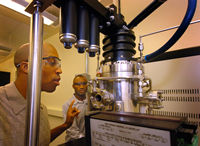Nanotechnology 'culture war' possible, says Yale study
Advertisement
Rather than infer that nanotechnology is safe, members of the public who learn about this novel science tend to become sharply polarized along cultural lines, according to a study conducted by the Cultural Cognition Project at Yale Law School in collaboration with the Project on Emerging Nanotechnologies. These findings have important implications for garnering support of the new technology, say the researchers.
The experiment involved a diverse sample of 1,500 Americans, the vast majority of whom were unfamiliar with nanotechnology, a relatively new science that involves the manipulation of particles the size of atoms and that has numerous commercial applications. When shown balanced information about the risks and benefits of nanotechnology, study participants became highly divided on its safety compared to a group not shown such information.
The determining factor in how people responded was their cultural values, according to Dan Kahan, the Elizabeth K. Dollard Professor at Yale Law School and lead author of the study. "People who had more individualistic, pro-commerce values, tended to infer that nanotechnology is safe," said Kahan, "while people who are more worried about economic inequality read the same information as implying that nanotechnology is likely to be dangerous."
According to Kahan, this pattern is consistent with studies examining how people's cultural values influence their perceptions of environmental and technological risks generally. "In sum, when they learned about a new technology, people formed reactions to it that matched their views of risks like climate change and nuclear waste disposal," he said.
The study also found that people who have pro-commerce cultural values are more likely to know about nanotechnology than others. "Not surprisingly, people who like technology and believe it isn't bad for the environment tend to learn about new technologies before other people do," said Kahan. "While various opinion polls suggest that familiarity with nanotechnology leads people to believe it is safe, they have been confusing cause with effect."
According to Kahan and other experts, the findings of the experiment highlight the need for public education strategies that consider citizens' predispositions. "There is still plenty of time to develop risk-communication strategies that make it possible for persons of diverse values to understand the best evidence scientists develop on nanotechnology's risks," added Kahan. "The only mistake would be to assume that such strategies aren't necessary."
"The message matters," said David Rejeski, director of the Project on Emerging Nanotechnologies. "How information about nanotechnology is presented to the vast majority of the public who still know little about it can either make or break this technology. Scientists, the government, and industry generally take a simplistic, 'just the facts' approach to communicating with the public about a new technology. But, this research shows that diverse audiences and groups react to the same information very differently."
Original publication: Nature Nanotechnology 2008.































































